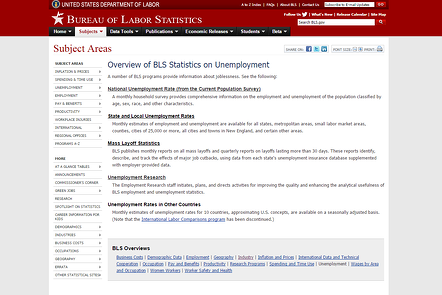In my last post, I promised a look at the BLS (Bureau of Labor Statistics) labor market data and where it comes from. I am going to start with a primer on the data quoted most often and where it comes from. If you know this or simply aren’t interested in the details, feel free to skip to the next section.
Employment Data Primer
There are two main data points that are picked up by most media outlets: the Unemployment Insurance Weekly Claims Report, which is reported every Thursday morning at 8:30 ET, and the monthly Employment Situation Report, which is reported the first Friday of every month at 8:30 ET.
 The Unemployment Claims Report compiles UI claims data from all states to provide both the number of new unemployment claims (claims filed by individuals who are newly unemployed) and the number of continuing claims (all those who are collecting unemployment from the state UI offices) for the previous week. However, the headline numbers that are reported leave out a very large subset of people who are currently receiving benefits: those who receive benefits through the various federal UI extension programs, of which there are quite a few. The biggest of those programs is the Emergency Unemployment Compensation Program or EUC – more detailed information on the EUC can be found here. The government does report the numbers for those claiming benefits from the various federal programs separately but within the same report.
The Unemployment Claims Report compiles UI claims data from all states to provide both the number of new unemployment claims (claims filed by individuals who are newly unemployed) and the number of continuing claims (all those who are collecting unemployment from the state UI offices) for the previous week. However, the headline numbers that are reported leave out a very large subset of people who are currently receiving benefits: those who receive benefits through the various federal UI extension programs, of which there are quite a few. The biggest of those programs is the Emergency Unemployment Compensation Program or EUC – more detailed information on the EUC can be found here. The government does report the numbers for those claiming benefits from the various federal programs separately but within the same report.
The monthly Employment Situation Report is a complex report that relies on two distinct surveys: the Current Population Study (CPS) and the Current Employment Statistics Survey (CES), known colloquially and respectively as the household survey and the payroll (or establishment) survey. There is a lot of data released in this report; but the headline unemployment rate (U3), which comes from the CPS, and the total non-farm payroll, derived from the CES, are the most noteworthy and widely-circulated numbers. The CPS is a survey of approximately 60,000 households and is anchored to the one week period which contains the 12th of each month. The CES is a survey of 140,000 businesses and government agencies representing over 400,000 worksites and is also anchored to the week that contains the 12th of the prior month.
The Discrepancy
Aside from the headline numbers that each survey produces, both surveys produce a lot of other data. While the CES is the source of official BLS data on employment count, the CPS, or household survey, also produces a count of employment. Interestingly, these data points diverge quite a bit and for many reasons. In the past two months there has been a significant divergence between the change in employment numbers reported by households (CPS) and the change reported by establishments (CES). On a seasonally-adjusted basis, while the well-circulated CES has shown losses of 62,000 jobs, the CPS has shown job gains of more than 800,000 jobs!
I should point out that each survey has its respective strengths and weaknesses; and generally, the CES is considered the more accurate source of data with respect to total employment count, in part due to an annual reconciliation process with unemployment claims data that often leads to rather large revisions in March for the 12-month period that ended the previous March. However, because of the limitations inherent in collecting information on company start-ups and companies ceasing operations, the CES relies quite a bit on what is called the birth/death model; and this model can be highly inaccurate. This model is the subject of a fair amount of controversy. There is enough uncertainty to suggest that it may be significantly understating the number of new jobs created during a time of entrepreneurial renewal.
Furthermore, the monthly CES data is subject to a number of revisions, including the aforementioned reconciliation with UI data – interestingly, the most recent reconciliation led to a 900,000 job revision (downward) for the period ending March 2009.
My point in all of this is that the household data MAY be confirming what our organization is already seeing in real-time – an accelerating demand for labor (at least in the insurance industries) that is not yet reflected in the official BLS data. As I have mentioned, we saw demand begin to uptick in October and then really intensify after the New Year.
If you are interested in more information on the discrepancies I site, the BLS has done four studies over the past 50 years to try to understand these discrepancies. The most recent of those was published in 2006 and can be found here.







